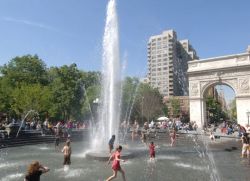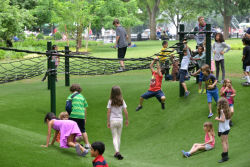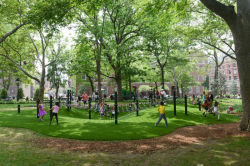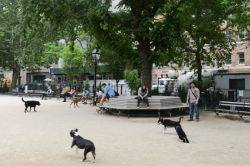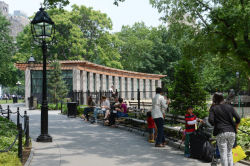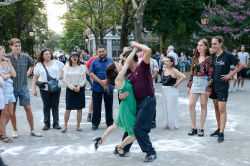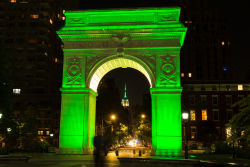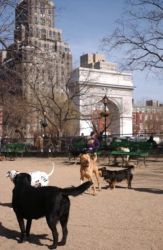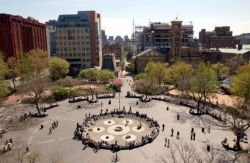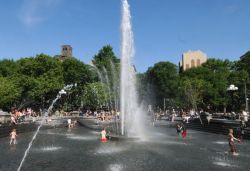Washington Square Park
Washington Square Park
What was here before?
This land was once a marsh fed by Minetta Creek, which was a water source for the Lenape village Sapokanikan, located in today’s West Village. The trail leading from the village to their inland planting fields later became the northern boundary of this park.
Shortly after New Amsterdam was established, the Dutch West India Company granted farm plots to settlers. In the 1640s, Willem Kieft, the director of the settlement, started granting freedom to those enslaved by the Company. The area became known as the Land of the Blacks after the first formerly enslaved African persons negotiated their freedom. In 1645 Anthony Portuguese received a land grant, followed by Manuel Trumpeter, both of whom farmed much of what is today’s Washington Square Park. When the English took over the colony in 1664, they withdrew the Black population’s rights and by 1716 all their property had been claimed by white landowners.
A yellow fever epidemic gripped the city in the 1790s, decimating neighborhoods and filling the cemetery then located at today's Madison Square Park. In 1797 the city's Common Council purchased a 90-lot parcel of land for a public burial ground, which accounts for the eastern two-thirds of what is now Washington Square Park. The surrounding area was sparsely populated, except for a few wealthy citizens who unsuccessfully contested the new potter’s field. The cemetery opened in 1797 and a year later almost 700 people had been buried there. Minetta Brook, which continued to flow through the potter's field, made the soil settle unevenly. Starting in 1808, a decade-long effort filled and diverted the stream to accommodate the cemetery and residential development.
The legend of “Hangman’s Elm” also dates to this period. Lore states that the 300-year-old English elm located at the park’s northwest corner was used to hang American Revolutionaries and prisoners after the war. However, only one hanging in the potter’s field was ever documented, that of Rose Butler (1799-1818), a young Black woman who was convicted of arson. Records indicate she was hanged at the gallows and buried only a few yards from where she was executed.
The potter’s field accommodated an estimated 20,000 burials. It was created as a secular burial ground reserved for those in the city who died indigent or alone. However, the Common Council made exceptions for the African Zion Methodist Episcopal Church, Pearl Street Church, and Cedar Street Church given the hardship churches endured during epidemics. Internments ceased in 1825 as residential and commercial development increased around the potter’s field.
The same year, the City purchased land to the west of the burial ground that was once owned by prosperous merchant William Ludlow. In 1826, the site was graded and turned into the Washington Military Parade Ground where voluntary militia companies trained and drilled. The city’s Seventh Regiment would later be called on to quell the nearby Astor Place Riot, a deadly anti-immigrant clash instigated by feuding Shakespearean actors, as well as the 1863 Draft Riots.
How did this site become a park?
To protect the property from encroaching development, the City purchased additional parcels to expand the parade grounds in 1827 and declared the property “ought forever thereafter to be and remain a public square…” Prominent families escaping the disease and congestion of downtown Manhattan moved into the area and built the distinguished Greek Revival mansions that still line the square’s north side. Several years later, New York University purchased property on its eastern side and attracted many scholars. In 1838 the park hosted the first public demonstration of the telegraph by Samuel F.B. Morse, an NYU professor.
Paths were added to the former parade ground in the mid-19th century. in 1871 the park was redesigned by M.A. Kellogg, Engineer-in-Chief, and Ignatz Pilat, Chief Landscape Gardener. Their plan offered a more rustic and informal space with curvilinear paths along its periphery, retaining many of the diagonal paths within the park’s core. The most dramatic change was the addition of a carriage drive through the park's interior connecting Fifth Avenue to Lower Manhattan, which required the fountain to be moved. It was replaced a couple of years later with today’s fountain, which was originally located at Fifth Avenue and East 59th Street. In 1878, the park was formally named Washington Square Park, after the Commander of the Continental Army and first President of the United States, George Washington.
The marble Washington Square Arch, designed by noted architect Stanford White, was built between 1890-1892 and replaced a plaster and wooden arch erected in 1889 to honor the centennial of the first president’sinauguration. Other monuments in this park are John Quincy Adams Ward’s bust of renowned engineer Alexander Lyman Holley (1890), Giovanni Turini’s statue of Italian-nationalist leader Giuseppe Garibaldi (1888), and a World War I commemorative flagpole.
Washington Square Park transformed socially and culturally in the 20th century. Following the Triangle Shirtwaist Factory fire in 1911, labor unions marched here. "Ashcan School" artists such as John Sloan painted in the park, and the bohemian community of the late 19th and early 20th centuries gathered here. The Beat Generation of the 1940s and ‘50s and the "folkies" of the late 1950s and early ‘60s also made the park their sanctuary. During this period the park became a renowned haven for performers and protestors.
During these social upheavals, Fifth Avenue ran through the Arch and an even larger highway was proposed to cut through the park. It wasn’t until the early 1960s that the park closed to traffic at the insistence of vigilant Greenwich Village residents, including Jane Jacobs and Shirley Hayes. A decade later the fountain was lowered and a two-tiered central plaza was created, which cemented its reputation as an ad hoc performance space. A mounded area to the southwest became a cherished play space, and chess and gaming tables at the south and northwest entryways created a vibrant culture with an international reputation.
Starting in 2003, the Washington Square Arch was restored and the park was redesigned. The fountain was raised and moved east to align with the Arch and Fifth Avenue, the Garibaldi monument was relocated, greenspace increased, and a new park house with restrooms was added.
Today Washington Square Park, rich in history, remains one of the jewels in the park system—serving as a dynamic commons for local residents, students, activists, chess players, performers, and tourists from around the globe.
Check out your park's Vital Signs
Clean & Safe
Green & Resilient
Empowered & Engaged Users
Share your feedback or learn more about how this park is part of a
Vital Park System

